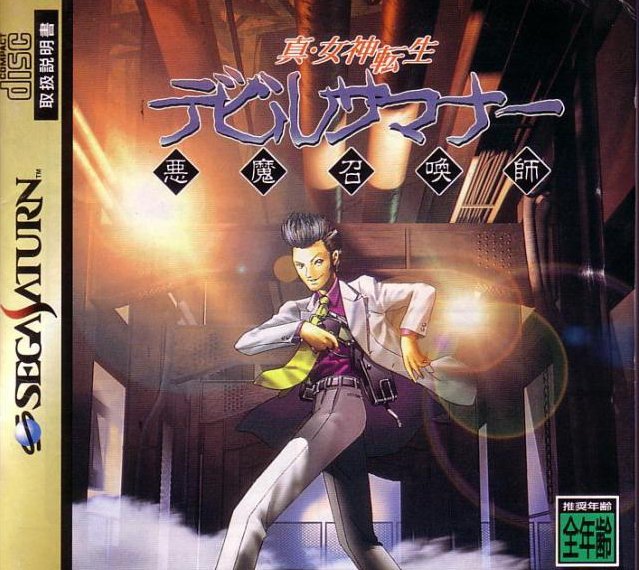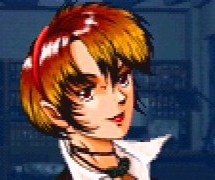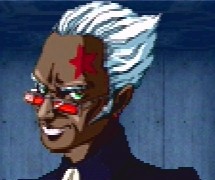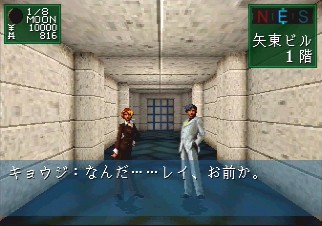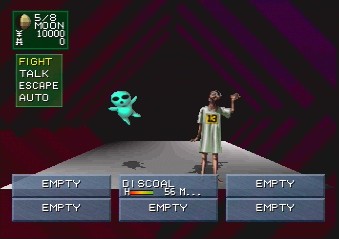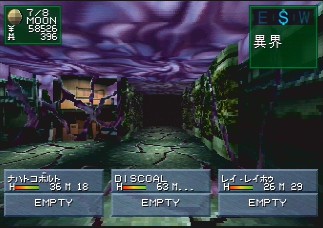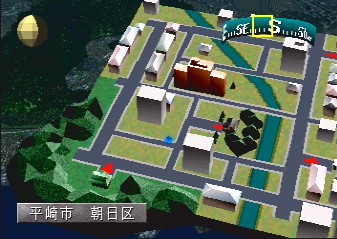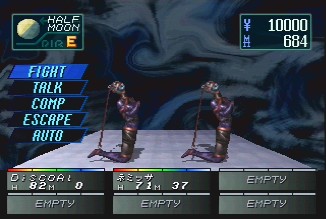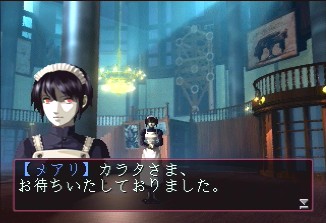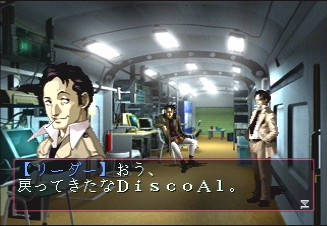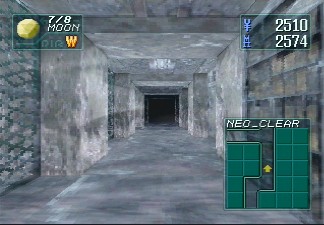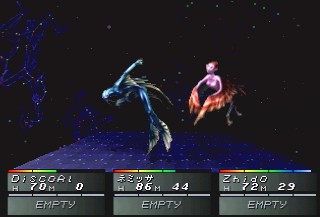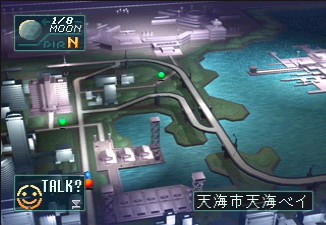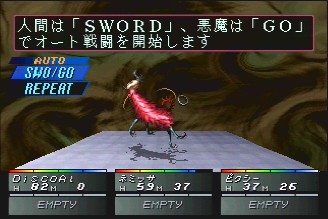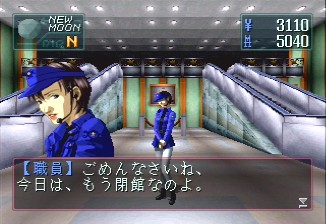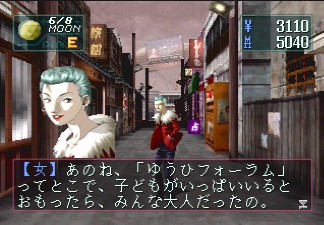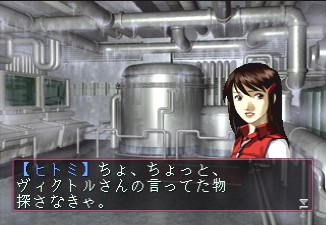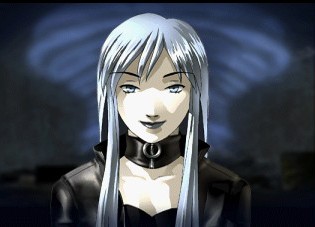
Devil Summoner
Devil Summoner
|
<<< Prior Page |
|
Page 1: |
Page 2: |
|
|
|
The first 32-bit Shin Megami Tensei game, Devil Summoner, made its way to the Saturn in 1995. Moving away from the apocalyptic themes of the original series, the setting is modern day suburban Japan, although demons have started to roam free. As the game begins, you're on a date with your girlfriend, and while heading back to her apartment building to grab some concert tickets she forgot, you're attacked by demons. No worries - you're saved by a suave demon hunter named Kyouji. Unfortunately, shortly after his heroic rescue, Kyouji is killed under mysterious circumstances. Things aren't going too well for you either - you're kidnapped and subsequently murdered by a crazy lunatic named Sid. Things in the afterlife don't go quite as planned, and your soul ends up in the reanimated body of Kyouji. After crawling out of the morgue, you team up with your partner Rei and try to solve the mysteries of the demon infiltration, as well as attempting to get everyone's soul back in the right place.
Characters
Kyouji Kuzunoha
The devil hunter who saves your ass, and later gets a little pissed off that you've inhabited his body. His ingame artwork lacks the silly pompadour seen in the cover artwork.
Rei Reihou
What good would devil hunters be without a sexy partner? No good, that's what. Rei is here to fill that void.
The 3D dungeons are now full screen and now possess a lot more detail, making them look much better than any of the previous games. This being the Saturn, however, the movement is pretty choppy and the draw distance is pretty low. The maps are now polygonal, and not particularly impressive looking. The battles have changed a little bit, as you now have a front row and back row, with only the characters in the front able to directly attack. The general flow of the battles are slower than the previous games, especially the plodding pace of the auto-battle. The enemy graphics are lacking, as they tend to look like barely animated, blurry masses of pixels. and the backgrounds are weird psychedelic clouds of color. The battle transitions are rather cool, as the floors and walls fly off into the distance before you face your opponents.
The conversation system has been changed slightly, as the monsters now will ask specific questions. More questionable is the introduction of the demon loyalty system. You need to keep your demons happy, otherwise you won’t be able to directly control their attacks. In the worse cases, they’ll ignore your commands altogether or even leave your party. It's an attempt to give depth to the game that adds more aggravation than fun. The multiple pathways and endings are also gone, as your alignment only determines what monsters can join your party. The dungeons can also grow to be incredibly difficult. It's a decent enough game, in spite the loyalty system and slow pace, although it feels very unpolished overall.
A few months after release, Atlus released "Devil Summoner: Akuma Zensho" or "Devil Dictionary", a fan disc that includes data and extra artwork about all of the monsters included in the game. Some of it is interesting, as it details the mythological origins behind all of the creatures, although more character artwork would have been nice, since it's pretty useless unless you can read Japanese. Devil Summoner was popular enough to warrant a reissue under the Saturn's "Sega Collection" label. A "Devil Summoner Special Box" was also released that included the game, the Akuma Zensho, a thick instruction manual that gave extra bits about the game's characters, and an 8 cm audio CDs that have a few arranged music tracks and commentary from the developers.
Devil Summoner was also ported to the PSP, with reduced difficulty and other minor conveniences. According to sources, Atlus was interesting in translating the title, but was apparently blocked by Sony America for not having enough new content added.
Quick Info:
|
Developer: |
|
|
Publisher: |
|
|
Genre: |
|
|
Themes: |
Shin Megami Tensei: Devil Summoner (Saturn)
Shin Megami Tensei: Devil Summoner (Saturn)
Shin Megami Tensei: Devil Summoner (Saturn)
Shin Megami Tensei: Devil Summoner (Saturn)
Shin Megami Tensei: Devil Summoner (Saturn)
Shin Megami Tensei: Devil Summoner (Saturn)
Shin Megami Tensei: Devil Summoner: Soul Hackers / Devil Summoner: Soul Hackers (デビルサマナー ソウル ハッカーズ) - Saturn, PlayStation, Nintendo 3DS (1997)
The sequel to Devil Summoner gives practically every aspect the ol' spit shine and ends up with a drastically improved game. While it uses the same engine, the draw distance is quite a bit better. The overworld map has been replaced with 2D CG rendered backdrops. Kazuma Kaneko's artwork finally hit its apex here, as the character artwork is far superior to all of the games prior. There's a lot of CG cutscenes, which is why the game is two CDs, although none of them are very impressive. The battle system is still ugly and slow, although the loyalty system has been fixed to make it less irritating than before. The dungeons are less painful too, although the more hardcore fans my balk at their relatively straightforward design, at least compared to the previous games. There are several bits of software you can install into your computer that help you out, including a useful onscreen map or the ability to save anywhere. Some of the music is good, despite some weird instrumentation, although a vast majority of the tracks are atmospheric.
And this is saying nothing of the plot. Taking place in the near future, you hack your way into a virtual reality world called Paradigm X. While it seems like your normal MMORPG, things get a bit wonky when you get creepy messages from an unknown source, threatening to steal your soul. Before you're sucked dry, you're saved by a fellow named Redman, who takes the form of various animals. For some reason, you have the souls of several other people trapped inside yourself. As you progress through the game, you're sent on several Native American-like vision quests, where you live the final moments of these trapped souls, most of whom were demon hunters before they were killed. Using the information you learn in taking on the roles of these people, you investigate the mysteries in the real world, and learn more about shady Algon Software Corporation, who created Paradigm X, as well as the mysterious Phantom Society.
Even though the number of player characters is limited (as usual), there are plenty of personalities abound in Soul Hackers:
Quick Info:
|
Developer: |
|
|
Publisher: |
|
|
Genre: |
|
|
Themes: |
Devil Summoner: Soul Hackers (Saturn)
Devil Summoner: Soul Hackers (Saturn)
Characters
Hitomi
The main character's best friend, Hitomi is a shy girl who is technically skilled but somewhat unsure of herself. She accompanies you until she is possessed by a demon known as Nemissa.
Spooky
The leader of the Spookies, he's one of the most mature members. His name (and the name of his group), as well as his basic design, seem loosely patterned on Fox Mulder from The X-Files, whose nickname was "Spooky".
One of the central bits of technology at the heart of Soul Hackers is the GUMP. Having nothing to do with Tom Hanks, GUMP stands for "Gun COMPuter", and allows for both demon summoning and old fashioned shooting.
While your primary party is sparse, your investigation is aided by the Spookies, a group of hackers who are also none too pleased about the outbreak of demons on your fair island. Certain characters, from the first Devil Summoner, like Rei Reiho, and Victor and his creepy maid, make a return as well.
While the battle system is still somewhat dull, the incredibly cool story and characters (the Hitomi/Nemissa combo is one of the coolest female characters in all of video game-dom) elevate Soul Hackers to a level of awesomeness that make it one of the Saturn's best RPGs.
Like Devil Summoner, an Akuma Zensho disc was also released separately. Soul Hackers was also ported to the PlayStation, although it is mostly the same as the Saturn original, with a few additions. One of the major differences is a bonus demon called the P-Mecha, which you can raise with your PocketStation and take into battle. Near the end of the Saturn game, one of the secondary characters is killed. In the PlayStation version, it's possible to avoid their death, though only during a second playthrough. The Saturn version also has an extra dungeon, which was only accessible by mailing a flyer to Atlus, who would send back a bonus disc that would unlock it. It is regularly available in the PlayStation version. There is also a Digest Mode, which lets you replay key cutscenes after restarting the game, and there are a few extra story scenes as well. It also has a playable demo of Persona 2: Innocent Sin. At one point, Atlus considered Soul Hackers for English localization, although for whatever reasons, it never came to be.
Additional Screenshots
Devil Summoner
|
<<< Prior Page |
|
Page 1: |
Page 2: |
|
|
|
